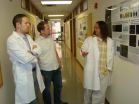(Press-News.org) DURHAM, N.C. -- Duke University engineers believe that continued advances in creating ever-more exotic and sophisticated man-made materials will greatly improve their ability to control light at will.
The burgeoning use of metamaterials in the field of optics does not rely on the limited set of materials found in nature, but rather man-made constructs that can be designed to control light's many properties. This control is gained by use of metamaterials, which are not so much single substances but entire man-made structures that can be engineered to exhibit properties not readily found in nature.
In their latest series of experiments, the Duke team demonstrated that a metamaterial construct they developed could create holograms -- like the images seen on credit or bank cards -- in the infrared range of light, something that had not been done before.
The Duke engineers point out that while this advance was achieved in a specific wavelength of light, the principles used to design and create the metamaterial in their experiments should apply in controlling light in most frequencies.
"In the past, our ability to create optical devices has been limited by the properties of natural materials," said Stéphane Larouche, research scientist in electrical and computer engineering at Duke's Pratt School of Engineering. "Now, with the advent of metamaterials, we can almost do whatever we want to do with light.
"In addition to holograms, the approach we developed easily extends to a broad range of optical devices," Larouche said. "If realized, full three-dimensional capabilities open the door to new devices combining a wide range of properties. Our experiments provide a glimpse of the opportunities available for advanced optical devices based on metamaterials that can support quite complex material properties."
The results of Larouche's experiments, which were conducted in the laboratory of senior researcher David R. Smith, a professor of electrical and computer engineering, appeared in an advanced online publication of the journal Nature Materials. The research was supported by the Army Research Office's Multidisciplinary University Research Initiative (MURI).
The metamaterial device fashioned by the Duke team doesn't look anything like a lens, though its ability to control the direction of rays passing through it surpasses that of a conventional lens. While traditional lenses are made of clear substances -- like glass or plastic -- with highly polished surfaces, the new device looks more like a miniature set of tan Venetian blinds.
These metamaterials are constructed on thin slabs of the same material used to make computer chips. Metal elements are etched upon these slabs to form a lattice-like pattern. The metal elements can be arranged in limitless ways, depending on the properties desired.
"There is unquestionable potential for far more advanced and functional optical devices if greater control can be obtained over the underlying materials," Larouche said. "The ability to design and fabricate the components of these metamaterial constructs has reached the point where we can now build even more sophisticated designs.
"We believe that just about any optical device can be made more efficient and effective using these new approaches," he said.
INFORMATION:
The other members of the team, all from Duke, were Yu-Ju Tsai, Talmage Tyler and Nan M. Jokerst.
Exotic materials will change optics, Duke researchers say
2012-03-19
ELSE PRESS RELEASES FROM THIS DATE:
Special Safety Issues Facing Older Drivers and Pedestrians
2012-03-19
As we most of us already know, aging usually means we'll experience more problems with our hearing, vision and motor skills. In order to grow older safely, we must first recognize our vulnerabilities. Once we do this, we can adapt our behavior in order to create a safer environment for ourselves and everyone else.
The following statistics shed light on the special safety issues facing seniors both behind the wheel and when walking around as pedestrians.
Safety Issues for Senior Drivers/Pedestrians
(Note: In 2009, approximately 40 million Americans were age 65 and ...
Bone marrow transplant arrests symptoms in model of Rett syndrome
2012-03-19
A paper published online today in Nature describes the results of using bone marrow transplant (BMT) to replace faulty immune system cells in models of Rett Syndrome. The procedure arrested many severe symptoms of the childhood disorder, including abnormal breathing and movement, and significantly extended the lifespan of Rett mouse models. Exploring the function of microglia deficient in methyl-CpG binding protein 2 (Mecp2), the protein encoded by the "Rett gene," principal investigator Jonathan Kipnis, Ph.D. and his team at the University of Virginia School of Medicine ...
The Viking journey of mice and men
2012-03-19
House mice (Mus musculus) happily live wherever there are humans. When populations of humans migrate the mice often travel with them. New research published in BioMed Central's open access journal BMC Evolutionary Biology has used evolutionary techniques on modern day and ancestral mouse mitochondrial DNA to show that the timeline of mouse colonization matches that of Viking invasion.
During the Viking age (late 8th to mid 10th century) Vikings from Norway established colonies across Scotland, the Scottish islands, Ireland, and Isle of Man. They also explored the north ...
The Japanese traditional therapy, honokiol, blocks key protein in inflammatory brain damage
2012-03-19
Microglia are the first line defence of the brain and are constantly looking for infections to fight off. Overactive microglia can cause uncontrolled inflammation within the brain, which can in turn lead to neuronal damage. New research published in BioMed Central's open access journal Journal of Neuroinflammation shows that, honokiol (HNK) is able to down-regulate the production of pro-inflammatory cytokines and inflammatory enzymes in activated microglia via Klf4, a protein known to regulate DNA.
Scientists from the National Brain Research Centre, Manesar, India, used ...
Hazy shades of life on early Earth
2012-03-19
A 'see-sawing' atmosphere over 2.5 billion years ago preceded the oxygenation of our planet and the development of complex life on Earth, a new study has shown.
Research, led by experts at Newcastle University, UK, and published today in the journal Nature Geoscience, reveals that the Earth's early atmosphere periodically flipped from a hydrocarbon-free state into a hydrocarbon-rich state similar to that of Saturn's moon, Titan.
This switch between "organic haze" and a "haze-free" environment was the result of intense microbial activity and would have had a profound effect ...
Marine Protected Areas are keeping turtles safe
2012-03-19
Marine Protected Areas (MPAs) are providing sea turtles with an ideal habitat for foraging and may be keeping them safe from the threats of fishing. A study by an international team of scientists led by the University of Exeter, published today (Thursday 15 March), shows that 35 per cent of the world's green turtles are found within MPAs. This is much higher that would be expected as only a small proportion of shallow oceans are designated as MPAs.
MPAs are areas of ocean in which marine activities such as fishing are restricted. Regulated by governments and NGOs, in ...
Personal Electronics Linked to Rise in Pedestrian Accidents
2012-03-19
A study recently released by the University of Maryland found that pedestrian fatalities are on the rise due to distractions from headphone use. The majority of incidents were found among men younger than 30 who lived in urban areas.
The issue is that headphones playing music directly in pedestrians' ears may hinder their ability to hear oncoming car horns, revving engines, beeping crosswalk lights and even blaring train whistles. The study was conceived after a train killed a teenager wearing headphones while crossing railroad tracks. The teenager's music had drowned ...
Looking at quantum gravity in a mirror
2012-03-19
Einstein's theory of gravity and quantum physics are expected to merge at the Planck-scale of extremely high energies and on very short distances. At this scale, new phenomena could arise. However, the Planck-scale is so remote from current experimental capabilities that tests of quantum gravity are widely believed to be nearly impossible. Now an international collaboration between the groups of Caslav Brukner and Markus Aspelmeyer at the University of Vienna and Myungshik Kim at Imperial College London has proposed a new quantum experiment using Planck-mass mirrors. Such ...
Innovative Company Brings New Coaching Model to the Accounting Profession and Better Small Business Expertise to Thousands of Small Business Owners
2012-03-19
While millions of accounting professionals are working the midnight oil to get Americans' tax returns complete for Uncle Sam, a few hundred accountants with brand new skills are helping small business owners improve their profits, while creating the businesses and lives of their dreams. These accountants are members of a brand new group called Accountant's Accelerator that's led by accounting industry veteran Sandi Smith Leyva. Coaching and especially group coaching programs such as Accountant's Accelerator is relatively new to the accounting profession; especially for ...
Stanford researchers boost potency, reduce side effects of IL-2 protein used to treat cancer
2012-03-19
STANFORD, Calif. -- The utility of a naturally occurring protein given, sometimes to great effect, as a drug to treat advanced cancers is limited by the severe side effects it sometimes causes. But a Stanford University School of Medicine scientist has generated a mutant version of the protein whose modified shape renders it substantially more potent than the natural protein while reducing its toxicity.
The findings will appear online March 18 in Nature.
The protein, known as interleukin-2 or IL-2, is a master regulator of the immune system. It acts as a growth factor ...



